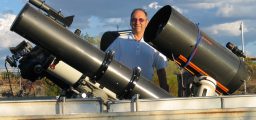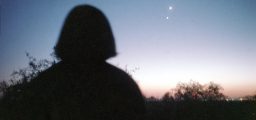Skyward March 2023 David H. Levy

Of comets, more comets, and Fritz Zwicky
Since October 1965, when I spotted my first comet, Comet Ikeya-Seki, I have seen 227 different comets. Near the dawn of my passion for the night sky, watching that mighty comet rise, apparently right out the St. Lawrence River, was a sight I shall never forget. The two most recent comets I have seen share the same name; they are both called Comet ZTF for Zwicky Transit Facility. This project t uses a new camera that offers a very wide field of view. The camera is attached to the large 48-inch Oschin Schmidt camera at Palomar.
This project has a rich history. It is loosely named for astronomer Fritz Zwicky, one of the founding astronomers at Palomar and one of the foremost scientists of the last century. He developed not the big Schmidt but the original smaller 18-inch Schmidt camera, the very first telescope atop that mountain. Since this project is named after Zwicky, why are its comets called “ZTF” instead of just Zwicky? It is because the comets are named for the project, not the man.
The historical Zwicky actually had little interest in comets. His career leaned towards the big questions of cosmology, the study of the large-scale issues of the Universe. But he was the first regular user of Palomar’s 18-inch Schmidt camera, the telescope Gene and Carolyn Shoemaker and I used to discover our comets, including the one that collided with Jupiter in 1994. That in itself was a tribute to Zwicky, for it offered insights into how comet impacts contributed to the origin of life on different worlds. Zwicky was not into comets, but he was deeply concerned with the distant explosions of massive stars that he and colleague Walter Baade called supernovae. When he began using the 18-inch there were 12 known supernovae. He discovered 121 supernovae with the 18-inch, 120 by himself and one with Paul Wild.
Even though I never met Zwicky, I can share three aspects of him, not including the most famous one in which he called anyone he did not like a
“spherical bastard.” The expression was intended to mean that no matter from which angle you look, that person is (or was) a bastard. One story I heard from Walter Hass, founder of the Association of Lunar and Planetary Observers, who said that when Zwicky was having a quiet chat in a corridor at Caltech with another astronomer, one could hear him two blocks away. The other involved Zwicky’s observing coat, which he left in a closet at the 18-inch observatory building. One night as I was about to observe alone there, as Gene Shoemaker left the building he said “If you get too cold, you can wear Zwicky’s coat! The thought of that coat haunted me all night. Third, my friend David Rossetter named his large 25-inch diameter reflector Fritz, after Zwicky’s first name. It is a wonderful telescope named for a brilliant man.
In January, the ion or gas tail of Comet ZTF showed a sort of disconnection in which the part of the tail closest to the comet was a thin line which suddenly broadened to a larger fan further out. This “disconnection event” was closely tied to a sudden increase in sunspot activity. This ZTF comet teaches us how comets interact with the solar wind.
As this article goes to press, there is not one ZTF comet, but two. David Rossetter and I saw the other one at our club’s dark observing site. The second one is much fainter, visible as an amorphous smudge of small slowly moving haze. As I looked at this second comet, I tried to understand and appreciate the seminal role that Zwicky played in his time. And in our time, that role has expanded to explore in still greater detail the night sky that he loved.




Comments are closed.